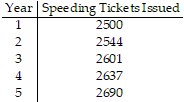Find the quotient using long division.
A. r2 + 2r + 2
B. 4r2 + 2r + 
C. 4r2 - 2r - 2
D. 4r2 + 2r + 2
Answer: D
You might also like to view...
Change the numbers to their percent equivalents.0.8
A. 80% B. 0.08% C. 800% D. 0.8%
Solve the problem.The following table shows the number of speeding tickets issued in a certain state for the past five years.  The polynomial function f(x) = -0.63x3 + 0.55x2 + 61.16x + 2439.2 models the number of speeding tickets issued over the past five years. Use this function to predict the number of speeding tickets issued in year 15. Round to the nearest whole number.
The polynomial function f(x) = -0.63x3 + 0.55x2 + 61.16x + 2439.2 models the number of speeding tickets issued over the past five years. Use this function to predict the number of speeding tickets issued in year 15. Round to the nearest whole number.
A. 1339 speeding tickets issued B. 437 speeding tickets issued C. -1075 speeding tickets issued D. 1354 speeding tickets issued
Use synthetic division to divide f(x) by x - k for the given value of k. Then express f(x) in the form  for the given value of k.f(x) = 3x5 + 4x4 + 2x2 - 1; k = -2
for the given value of k.f(x) = 3x5 + 4x4 + 2x2 - 1; k = -2
A. f(x) = (x + 2)(3x4 + 2x3 + 4x2 + 8x) - 15 B. f(x) = (x + 2)(3x4 - 2x3 + 4x2 + 6) - 13 C. f(x) = (x + 2)(3x4 - 2x3 + 6x2 - 12) + 23 D. f(x) = (x + 2)(3x4 - 2x3 + 4x2 - 6x + 12) - 25
Find the zeros of the polynomial function. State whether the graph crosses the x-axis, or touches the x-axis and turns around, at each intercept. f(x) = (x + 1)(x - 2)(x - 1)2
A. x = 1, crosses the x-axis; x = -2, crosses the x-axis; x = -1, touches the x-axis and turns around B. x = -1, crosses the x-axis; x = 2, crosses the x-axis; x = 1, crosses the x-axis C. x = 1, crosses the x-axis; x = -2, touches the x-axis and turns around; x = -1, touches the x-axis and turns around D. x = -1, crosses the x-axis; x = 2, crosses the x-axis; x = 1, touches the x-axis and turns around